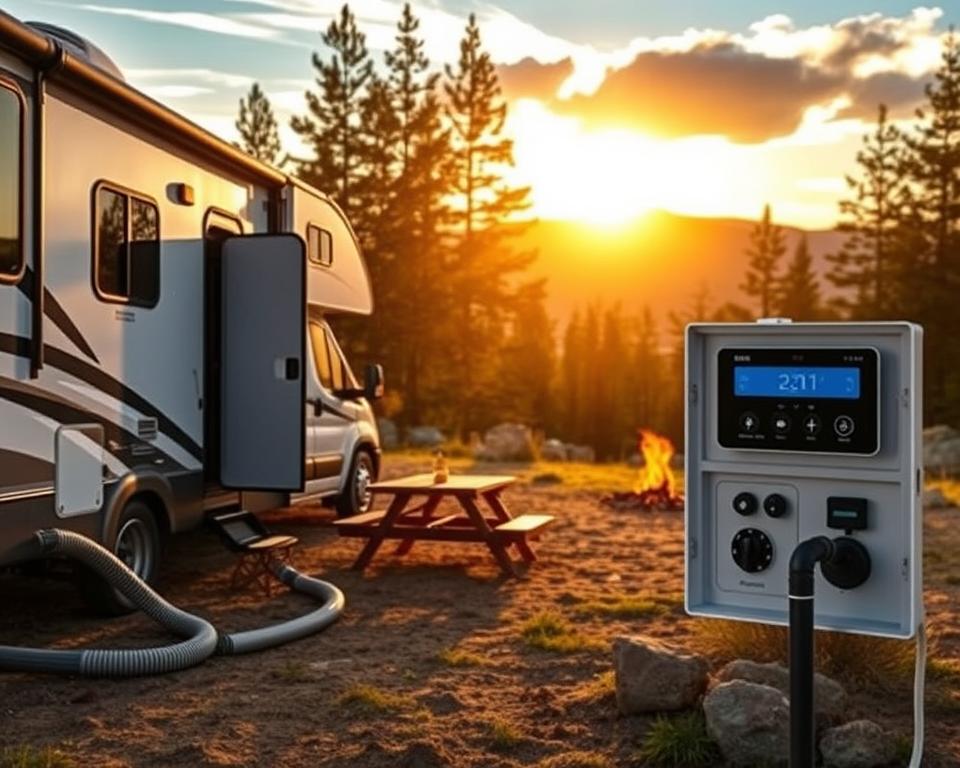RV Black Water Tank Pump: Tips for Guidance and Upkeep
The RV black water tank pump plays a significant role in your RVing experience, have you considered its impact? A crucial aspect of your RV’s hygiene system is the black water tank pump. Seamless travel depends on the correct maintenance of this pump. Inside, you’ll discover key information on how to manage your RV waste water pump. If you understand its importance, you can optimize its performance and have even better RV experiences.
Main Insights
- Effective waste management heavily relies on the RV black water tank pump.
- Keeping up with regular maintenance will help your RV waste water pump last longer.
- If you understand the system’s components, you’ll be better at fixing problems.
- To maintain hygiene and care for the environment, safe dumping practices are necessary.
- Winter preparation of your RV black water tank system helps avoid expensive fixes.
- Maintaining the cleanliness of your RV sanitation pump will help avoid clogs and unpleasant smells.
RV Water Tanks: An Overview
For trouble-free camping with RV septic pumping service near me, it’s possible that many RV owners don’t fully realize the significance of various water tanks. It’s essential to know what the RV fresh water, gray water, and black water tanks do. Each plays a unique role and needs proper care.
Potable water is kept in the RV fresh water tank. It’s used for drinking, cooking, and hygiene. Maintaining the cleanliness of this tank and the safety of its water is crucial. Fresh water is crucial for hydration and health during travels.
In contrast, the RV gray water tank holds the water that has been used in sinks and showers. This tank can quickly become full, requiring frequent checks and draining. For a clean living space in your RV, you must manage the gray water tank appropriately.
Toilet waste is held in the RV black water tank, making it a critical component. It demands constant vigilance to avoid smells and buildup. The condition of the tank and your experience can be improved by using suitable tank chemicals. Knowing how to care for each tank makes RV trips more enjoyable.
Defining the RV Black Water Tank Pump
For the sanitation systems of recreational vehicles, the RV black water tank pump is essential. The pump’s function is to move waste to the appropriate disposal areas. To maintain it correctly and avoid expensive problems, you need to know how it works.
RV owners can choose from various pump types, including the sewer pump. The macerator pump is a favorite because it grinds waste, making disposal faster. This is particularly useful when dump stations are crowded.
A quality RV black tank pump is crucial for waste management. It ensures that the RV remains clean and comfortable for occupants. By regularly checking and knowing how your pump works, you can improve your RV experience.
Knowing the Different Parts of the Black Water Tank System
The RV black water tank system must be understood for proper waste management. Many important parts are involved, and they work together to make sure everything runs smoothly. Holding the waste from the RV’s toilet, the black water tank is the most important part. It’s made with durable materials so that it can handle various conditions.

Transferring waste to a specific dump station, the system’s pump is very important. It is indispensable for RV owners. Providing a flexible link between the tank and the dump station, sewer hoses are also very important. By preventing leaks and containing odors, these hoses ensure a clean waste disposal process.
To attach sewer hoses and allow for efficient waste transfer, connection ports are necessary. Managing the flow of waste depends on termination valves. To maintain sanitation, they prevent waste from flowing back and stop spills during disposal.
Knowing about these essential parts helps RV owners keep their sanitation system running well. Knowing this is crucial for fixing problems while traveling or using the RV, which improves the whole RV experience.
Using Your RV Black Water Tank Pump Correctly
Knowing how to use the RV sanitation pump well greatly improves your experience as an RV owner. For a system that runs smoothly, it’s essential to know how to use the black tank correctly. After each use, it’s critical to flush the tank thoroughly. This practice helps avoid the buildup of solid waste, which might result in blockages and other issues.
Performing regular checks on your RV sanitation pump ensures it functions as expected. Taking this action beforehand can help you avoid any unpleasant occurrences while traveling. Another essential thing is to use toilet paper that is specially made for RVs. Because it’s designed to break down quickly, this type of toilet paper reduces the risk of clogs.
Keeping the termination valves closed, except during emptying, is another vital practice. This helps prevent bad smells. Using tank deodorants and cleaners will also help keep the system smelling good and clean. Adhering to these guidelines enhances your experience with the RV black water tank.
| Guidelines for Using Your Black Tank Correctly | Results |
|---|---|
| Flush Using a Good Amount of Water | Stops clogs from solid waste |
| Routinely Check the Pump’s Operation | Guarantees it’s working properly |
| It’s Important to Use RV-Specific Toilet Paper | Lowers the chance of clogs |
| Always Keep the Termination Valves Closed | Reduces smells |
| It’s Good to Use Tank Deodorizers and Cleaners | Ensures the system remains hygienic and without odors |
Top Maintenance Tips for the Black Water Tank Pump
To ensure your RV’s black water tank pump lasts longer and works efficiently, it’s crucial to maintain it regularly. This includes using the right chemical treatments specifically made for these tanks. Waste is broken down efficiently by them, and they also prevent odors.
Ensuring an adequate amount of water is used when flushing the toilet is also critical. By doing this, waste can move to the tank without problems, lowering the risk of it building up. Additionally, don’t forget to regularly deep clean the tank and its components. For this vital task, be sure to use the recommended tools.
To avoid any issues, always check the levels in the tank. Make sure to address any leaks or overflows as soon as you see them. It’s important to empty the tank regularly so that solid waste doesn’t build up. By setting up a maintenance schedule, you can help ensure a trouble-free experience with your RV.
| Maintenance Task | Timing | Description |
|---|---|---|
| Check levels | Each and every trip | Ensure the tank is not overfilled to prevent leaks. |
| Apply chemical treatment | Every time you empty it | Make sure to add treatments that will break down waste effectively. |
| Flush the system | Every month | To maintain the cleanliness of the tank, use a cleaning solution. |
| Look over the pump | Before going on long journeys | Make sure there’s no wear and tear to prevent the pump from breaking down while you’re traveling. |
| Empty the tank | As needed | Empty the tank when it’s full, and try to use designated dump stations if possible. |
By adhering to these essential maintenance steps, you can ensure your black water tank pump works well. This will enhance your RV trips significantly.
Troubleshooting Common Problems with Your Black Water Tank Pump
Fixing problems with the black tank pump can appear challenging. Many people who own RVs run into various issues with their RV black tanks, such as blockages, leaks, or ongoing bad smells. If you know how to deal with these problems early on, you can save time and money on repairs.
Begin by examining the hoses that are linked to the black tank pump. It’s common for blockages to occur in these hoses, resulting in the pump not working properly. Detach the hoses and check them for any accumulation or foreign matter. Should you find any blockages, clean the hoses thoroughly before you reattach them.
The next step is to evaluate the seals around the pump and the tank. Damaged seals can result in leaks that may go unnoticed until significant damage has occurred. If you find any seals that are not working properly, replace them right away to stop more problems from happening.
Using enzyme treatments can be beneficial for odors that persist. These treatments help to break down the waste and lessen the unpleasant smells. To get the best results, be sure to follow the instructions that came with the product.
This is a table that quickly shows common problems and how to fix them:
| Issue | Likely Cause | Solution |
|---|---|---|
| Clogs | Accumulation of material in the hoses or tank | Make sure to check and clean the hoses |
| Drips | Seals that are not working properly | Check the seals and replace them if needed |
| Unpleasant smells | Waste that has built up | Apply enzyme treatments |
| Pump failure | Issues with the wiring | Inspect the connections and battery |
Recognizing the warning signs early on can prevent minor issues from turning into major problems with your RV black tank. If you maintain it regularly and keep a close watch, your black tank pump will last longer, which will make better your RV experience.
RV Black Water Tank Pump Cleaning Techniques
Keeping your RV’s black water tank clean is essential for hygiene and its plumbing system. Make it a goal to rinse with fresh water after each use to minimize odors and ensure smooth operation. It helps prevent waste from accumulating and maintains the condition of the tank.
If you need a more intensive clean, use cleaning solutions that are formulated for black water systems. These products are good at dissolving waste and fighting bad smells. Put water and the cleaning solution in the tank, and then let it sit. If your RV has a flush system that’s built in, it will make cleaning easier.
Driving with sharp turns or using sloshing techniques can help to stir up the contents of the tank. This helps loosen residue on the tank walls. Cleaning in this way helps the sensors be more accurate, which can help you avoid sewage problems.
Safe Dumping Practices at Dump Stations
Knowing how to act properly at RV dump stations is crucial for maintaining a pleasant environment for everyone. Upon reaching a station, make sure your RV is positioned correctly. Then, get your gear ready for dumping.
For a smooth process, make sure to follow these steps closely:
- Confirm that your sewer hose is firmly attached to the station’s connection point.
- The first step is to open the black water valve so the sewage can flow out.
- After the black tank empties, close its valve. Then, open the gray water valve to clean the hose with the less dirty water.
- Once the process is complete, carefully detach your hose to prevent any spillage.
- Be sure to always clean your hoses with water that’s safe to drink and then put them away immediately.
Another crucial thing is to follow the local rules for disposing of waste. To protect the environment, many areas have rules that you are required to follow. Ignoring these rules can result in fines or other penalties.
Being considerate at RV dump stations helps to improve the experience for everyone. When you keep the area clean and follow the rules, it shows you care about the community. These actions promote a sense of responsibility among RV enthusiasts and encourage camping habits that are environmentally conscious.
Steps to Winterize Your RV Black Water Tank System
To ensure your black water system doesn’t freeze, winterizing your RV tanks is essential. You need to prepare properly to avoid damage that can be caused by frozen water in the system. Following specific steps ensures effective winter care of the RV black tank.
- First, make sure to completely drain the black water tank using the appropriate pump and connections.
- Next, bypass the water heater to prevent water from entering and accumulating in the unit.
- Use RV-specific antifreeze, as regular antifreeze can be toxic and harmful to the environment. Pour the antifreeze into the system according to the product instructions.
- Make sure to leave all faucets and drains open so that any leftover water can get out and the antifreeze can circulate.
- Finally, check that all access panels are sealed and secure to prevent water intrusion during winter months.
These winterization steps help RV owners protect their black water tank systems from the damaging effects of winter. This kind of planning helps you avoid having to pay for expensive repairs or maintenance when the seasons change.
In Summary
Successful RV ownership relies heavily on efficient maintenance of the RV black water tank. Understanding the black water tank pump and following the maintenance plans in this guide will lead to more enjoyable travels. By taking good care of your equipment, you’ll extend its life and simplify the process of managing waste in your RV. This makes travel less daunting.
Understanding your RV’s black water system is crucial for tackling issues as they arise. Following good maintenance, troubleshooting, and cleaning procedures will help prevent unexpected malfunctions. This lets you enjoy worry-free road trips. Services like All in Sanitation, which have a good reputation, can help you with your maintenance. They give you the important products and support you need for great care.
To be a good RV owner, you need to be attentive and take proper care of all parts of your vehicle, including the black water tank. Armed with this information, you’re ready to explore freely. You’ve made all the correct decisions to guarantee a wonderful journey for yourself and those with you.


